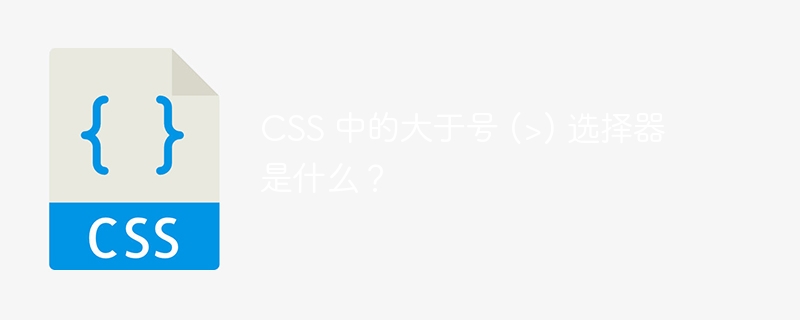Home >Web Front-end >CSS Tutorial >What is the greater-than (>) selector in CSS?
What is the greater-than (>) selector in CSS?
- 王林forward
- 2023-08-29 12:09:021187browse

In CSS, the ">" symbol is not used to compare two values like in other programming languages. Here, we use the greater than sign (>) as a selector.
In CSS, selectors are used to select single or multiple HTML elements. Whenever we use the greater than sign in a selector, it will select the direct child elements of the parent element, but not the deeply nested child elements.
grammar
Users can use the greater than sign in CSS selectors according to the following syntax.
selecter1>selector2 {
/* CSS code */
}
In the above syntax, "selector1" is the parent element and "selector2" is the direct child element. Therefore, we define the styles of the child elements in the declaration block.
Example 1
In the example below, we create an ordered list of HTML elements. In CSS, we use the "ol>li" selector, which means to select all "ol" HTML elements that are direct children of the "li" element.
In the output, the user can observe that all elements in the list turn blue because all "li" are direct children of "ol".
<html>
<head>
<style>
ol>li {
color: blue;
}
</style>
</head>
<body>
<h3>Using the <i> (>) CSS selector </i> to select direct child elements in CSS</h3>
<ol>
<li> HTML </li>
<li> CSS </li>
<li> JavaScript </li>
<li> NodeJS </li>
</ol>
</body>
</html>
Example 2
In the example below, we have a div element that contains "p" elements at different levels. Inside the div element, we added the "ht4" element and the "p" element. Therefore, we added "p" elements at the second and third depth levels.
In CSS, we use the "div>p" CSS selector to select all direct "p" elements of a div element. Additionally, we have used the "div p" CSS selector, which selects all "p" elements within a div element.
In the output, the user can observe that "color: red" is only applied to the first "p" element since it is the only direct child of the div element. When the "div p" CSS selector selects child elements from all levels, "background-color: aqua" will be applied to all "p" elements.
<html>
<head>
<style>
div>p {
color: red;
}
div p {
background-color: aqua;
}
</style>
</head>
<body>
<h3>Using the <i> (>) CSS selector </i> to select direct child elements in CSS</h3>
<div>
<p> This paragraph is at the first level. </p>
<h3>
<p> This paragraph is at the second level. </p>
<h4>
<p> This paragraph is at the third level. </p>
</h4>
</h3>
</div>
</body>
</html>
Example 3
In the example below, we use the greater than sign to select HTML elements from a deeply nested level. Here, the "container" HTML element contains the unordered list, and we have also created the unordered list outside the "container" element.
In CSS, we use the '.container>ul>li' CSS selector to select all 'li' elements that are direct children of the 'ul' element, where the 'ul' element should be of the 'ul' element An element whose direct child element has the class name "Container".
In the output, we can see that all CSS is only applied to nested lists.
<html>
<head>
<style>
.container>ul>li {
color: red;
padding: 3px;
background-color: green;
font-size: 1.3rem;
}
</style>
</head>
<body>
<h3>Using the <i> (>) CSS selector </i> to select direct child elements in CSS</h3>
<div class = "container">
<ul>
<li> one </li>
<li> Two </li>
<li> Three </li>
</ul>
</div>
<ul>
<li> Four </li>
<li> Five </li>
<li> Six </li>
</ul>
</body>
</html>
Users learned to use the greater than sign (>) CSS selector in CSS. It is used to select direct child elements of a specific element. Here we can use HTML tags, class names, IDs, etc. CSS selector with a greater than sign (>).
The above is the detailed content of What is the greater-than (>) selector in CSS?. For more information, please follow other related articles on the PHP Chinese website!

